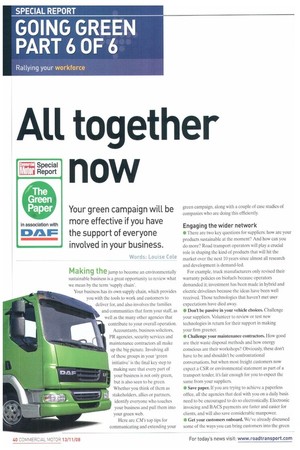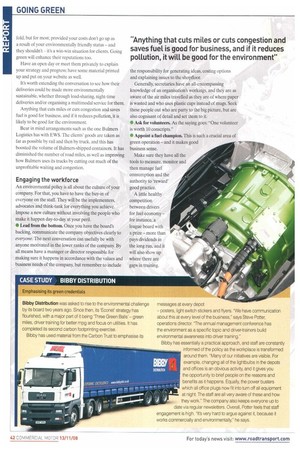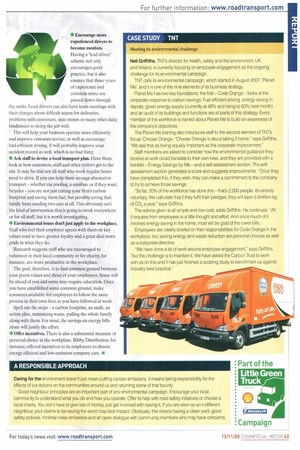ALL together now
Page 40

Page 42

Page 43

If you've noticed an error in this article please click here to report it so we can fix it.
Your green campaign will be more effective if you have the support of everyone involved in your business.
Words: Louise Cole Making the jump to become an environmentally sustainable business is a great opportunity to review what we mean by the term supply chain'.
Your business has its own supply chain, which provides you with the tools to work and customers to deliver for, and also involves the families and communities that form your staff, as well as the many other agencies that contribute to your overall operation.
Accountants, business solicitors, PR agencies, security services and maintenance contractors all make up the big picture. Involving all of these groups in your 'green initiative* is the final key step to making sure that every part of your business is not only green, but is also seen to be green. Whether you think of them as stakeholders. allies or partners. identify everyone who touches your business and pull them into your green web.
Here are CM's top tips for communicating and extending your green campaign, along with a couple of case studies of companies who are doing this efficiently.
Engaging the wider network
• There are two key questions for suppliers: how are your products sustainable at the moment? And how can you do more? Road transport operators will play a crucial role in shaping the kind of products that will hit the market over the next 10 years since almost all research and development is demand-led.
For example, truck manufacturers only revised their warranty policies on biofuels became operators demanded it; investment has been made in hybrid and electric drivelines because the ideas have been well received. Those technologies that haven't met user expectations have died away.
• Don't be passive in your vehicle choices. Challenge your suppliers. Volunteer to review or test new technologies in return for their support in making your firm greener.
• Challenge your maintenance contractors. How good are their waste disposal methods and how energy conscious are their workshops? Obviously, these don't have to be and shouldn't be confrontational conversations, but when most freight customers now expect a CSR or environmental statement as part of a transport tender, it's fair enough for you to expect the same from your suppliers.
• Save paper. If you are trying to achieve a paperless office, all the agencies that deal with you on a daily basis need to be encouraged to do so electronically. Electronic invoicing and BACS payments are faster and easier for clients, and will also save considerable manpower.
• Get your customers onboard. We've already discussed some of the ways you can bring customers into the green fold, but for most, provided your costs don't go up as a result of your environmentally friendly status and they shouldn't it's a win-win situation for clients. Going green will enhance their reputations too.
Have an open day or meet them privately to explain your strategy and progress; have some material printed up and put on your website as well.
It's worth extending the conversation to see how their deliveries could be made more environmentally sustainable, whether through load-sharing, night-time deliveries and/or organising a multimodal service for them.
Anything that cuts miles or cuts congestion and saves fuel is good for business, and if it reduces pollution, it is likely to he good for the environment.
Bear in mind arrangements such as the one Bulmers Logistics has with EWS, The clients' goods are taken as far as possible by rail and then by truck, and this has boosted the volume of Bulmers-shipped containers. It has diminished the number of road miles, as well as improving how Bulmers uses its trucks by cutting out much of the unprofitable waiting and congestion.
Engaging the workforce
An environmental policy is all about the culture of your company. For that, you have to have the buy-in of everyone on the staff. They will be the implementers, advocates and think-tank for everything you achieve. Impose a new culture without involving the people who make it happen day-to-day at your peril.
• Lead from the bottom. Once you have the board's backing, communicate the company objectives clearly to everyone. The next conversation can usefully be with anyone motivated in the lower ranks of the company. By all means have a manager or director responsible for making sure it happens in accordance with the values and business needs of the company, but remember to include the responsibility for generating ideas, costing options and explaining issues to the shopfloor.
Generally, secretaries have an all-encompassing knowledge of an organisation's workings, and they are as aware of the air miles travelled as they are of where paper is wasted and who uses plastic cups instead of mugs. Seek these people out who are party to the big picture. but are also cognisant of detail and set them to it.
• Ask for volunteers. As the saying goes: "One volunteer is worth 10 conscripts."
• Appoint a fuel champion. This is such a crucial area of green operation and it makes good business sense.
Make sure they have all the tools to measure, monitor and then manage fuel consumption and the authority to 'reward' good practice.
A little healthy competition between drivers for fuel economy for instance, a league board with a prize more than pays dividends in the long run, and it will also show up where there are gaps in training. • Encourage more experienced drivers to become mentors. Having a 'lead driver' scheme not only encourages good practice, but it also ensures that those years of experience and common sense are passed down through the ranks. Lead drivers can also have team meetings with their charges about difficult access for deliveries, problems with customers, near misses or many other daily hindrances to doing the job well.
This will help your business operate more efficiently and improve customer service, as well as encourage fuel-efficient driving. It will probably improve your accident record as well, which is no bad thing.
• Ask staff to devise a local transport plan. Have them look at how customers, staff and other visitors get to the site. it may be that not all staff who work regular hours need to drive. If you can help them arrange alternative transport -whether car pooling, a minibus, or if they want, bicycles you are not just cutting your firm's carbon footprint and saving them fuel, but possibly saving that family from needing two cars at all. This obviously isn't the kind of intervention that is going to work everywhere or for all staff, but it is worth investigating.
• Environmental issues don't just apply to the workplace. Staff who feel their employer agrees with them on key values tend to have greater loyalty and a great deal more pride in what they do_ Research suggests staff who are encouraged to volunteer in their local community or for charity, for instance, are more productive in the workplace.
The goal, therefore, is to find common ground between your green values and those of your employees. Some will be ahead of you and some may require education. Once you have established some common ground, make resources available for employees to follow the same process in their own lives as you have followed at work.
Spell out the steps a carbon footprint, an audit, an action plan, minimising waste, pulling the whole family along with them. For most, the savings on energy hills alone will justify the effort.
Offer incentives. There is also a substantial measure of personal choice in the workplace. Bibby Distribution, for instance, offered incentives to its employees to choose energy efficient and low-emission company cars. •












































































































































































